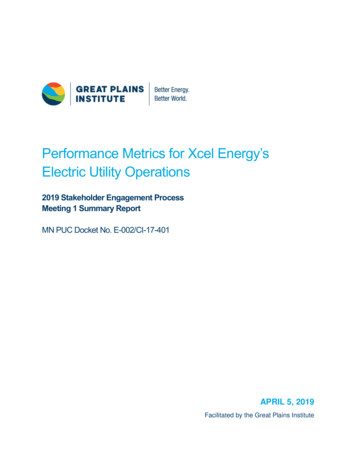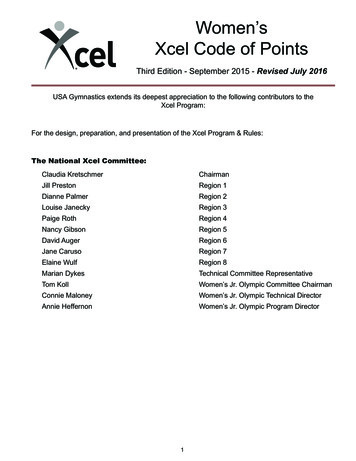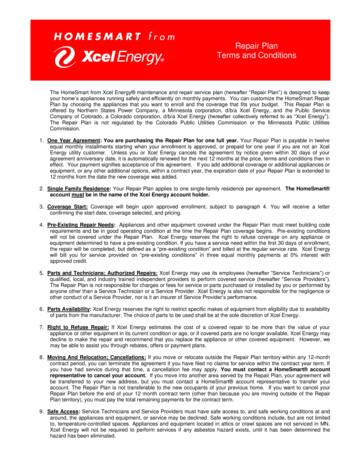
Transcription
Performance Metrics for Xcel Energy’sElectric Utility Operations2019 Stakeholder Engagement ProcessMeeting 1 Summary ReportMN PUC Docket No. E-002/CI-17-401APRIL 5, 2019Facilitated by the Great Plains Institute
2
About this ReportAUTHORSTrevor Drake and Doug Scott, Great Plains InstituteADDITIONAL CONTRIBUTORSRolf Nordstrom, Great Plains InstituteATTRIBUTION OF STAKEHOLDER COMMENTSThe stakeholder comments summarized in this report represent the collective insights shared byparticipants at the March 20, 2019 meeting for MN PUC Docket No. E-002/CI-17-401.Summarized comments should not be attributed to any particular individual or organization.ACKNOWLEDGEMENTSThe Great Plains Institute would like to thank the Minnesota Public Utilities Commission for theopportunity to serve as the facilitator for Docket 17-401, as well as the McKnight Foundation forits generous support of this work. We’d also like to thank the participants, observers, facilitators,and notetakers who attended the March 20, 2019 stakeholder meeting for their engagement andthoughtful participation in evaluating utility performance metrics for Xcel Energy’s electric utilityoperations.ABOUT THE GREAT PLAINS INSTITUTE (GPI)A nonpartisan, national, nonprofit organization, the Great Plains Institute (GPI) is transformingthe energy system to benefit the economy and environment. We combine a unique consensusbuilding approach, expert knowledge, research and analysis, and local action to find andimplement lasting solutions. Our work strengthens communities and provides greater economicopportunity through creation of higher paying jobs, expansion of the nation’s industrial base, andgreater domestic energy independence while eliminating carbon emissions.Learn more at www.betterenergy.org.QUESTIONS ABOUT THIS REPORTQuestions should be directed to Trevor DrakeGreat Plains Institute2801 21st Ave S, Suite 220Minneapolis, MN 55407tdrake@gpisd.net612-767-72913
ContentsExecutive Summary . 8Background . 10Introduction .10Background on performance-based regulation . 10Performance-based regulation in Minnesota . 11Stakeholder Engagement Process.13Overall process design. 13Meeting 1 details . 14Outcome and Metric Summaries. 17How to Read the Outcome and Metric Summaries .17Quick guide to reading the summaries . 17How metrics were discussed at the meeting . 17Origin of the metrics . 19Topics versus metrics . 19Existing versus new metrics . 19Affordability .20Average bills . 20Capacity costs . 20Cost-effective alternative resources . 21Customer costs . 21Delinquency . 21Deposits . 21Disconnections . 22Energy costs . 22Energy poverty heat map . 22Fuel costs . 22Geographic distribution of resources . 23Integrated resource plan/Integrated distribution plan forecast accuracy . 23Line costs . 23Participation in affordability programs . 24Participation in efficiency programs (of customers eligible for affordability programs) . 244
Quality of considerations in integrated resource planning . 25Rate by class . 25Societal externalities . 25Reliability, including Customer and System-Wide Perspectives .26Advanced metering . 26Aggregate power plant efficiency . 27Capacity factor . 27Cyber security . 27Demand response . 27Distributed energy resources . 28Distribution line controls . 28Flexible resources . 29Grid modernization . 29Generator availability . 29Interruptions . 29Meter reading performance . 30Net metering . 30Participation in load shape programs. 30Power quality . 31Locational reliability . 31Preventative maintenance . 31Resilience . 31Storage . 32System losses . 32Customer Service Quality, including Satisfaction, Engagement, and Empowerment .33Billing/invoice accuracy . 33Bill-paying convenience/choice . 34Call center quality. 34Customer complaints . 34Customer products/services . 34Customer satisfication with third parties -- not under contract . 35Customer satisfaction with third parties -- under contract. 35Customer satisfaction with utility . 355
Customer usage data access . 36Cyber security . 36Delinquency . 36Disconnections . 37Interconnection support. 37Low-income products/services . 37Order fulfillment . 38Outage communications . 38Outage refunds . 38Participation in affordability programs . 38Rate options . 39Service appointment quality . 39Third party satisfaction with utility . 39Environmental Performance, including Carbon Reductions and BeneficialElectrification .40Alignment of water and energy systems . 40Beneficial electrification. 40Carbon emissions . 40Carbon intensity . 41Carbon reduction costs . 41Community solar . 41Cumulative distributed energy resource effects . 42Economy-wide carbon reductions . 42Electric space/water heating . 42Electric vehicles . 42Energy efficiency . 43Fossil carbon emissions rate . 43Fuel switching . 43Geographic placement of resources . 44Green pricing . 44Other environmental benefits . 44Renewable energy . 44Solar energy . 45Cost Effective Alignment of Generation and Load, including Demand Response .466
Advanced (innovative) generation technologies . 46Advanced metering . 46Avoided or deferred investments . 47Combined heat and power capacity. 47Demand response . 48Distributed energy resources . 48Electric vehicle managed charging . 48Energy efficiency . 48Estimated curtailment. 49Geographic placement of distributed energy resources . 49Grid optimization . 50Integration of new loads . 50Load factor . 50Load shape investment . 51Load shape . 51Load shifting . 51Participation in load shape programs. 52Peak load reduction . 52Rate options to affect load shape . 52Realtime generation and load synchronization . 52Reduction in line losses . 53Overall Feedback and Next Steps . 54Overall Stakeholder Feedback .54Measuring outcomes, not deployment . 54Technology neutrality as a consideration. 54Utility influence and control . 55Consideration of possible regulatory reforms . 55Limiting the number of metrics . 55Overlap among the five outcomes . 55Existing versus new metrics . 55Next Steps .567
Executive SummaryAround the country, utility commissioners and other policy makers are taking a fresh look at thetraditional cost-of-service utility business model, which was designed to promote the expansionof electric service throughout the country. Compensation was based on making the utility wholefor their cost of delivering electricity service, plus a return on equity to pay back utilityshareholders for their investment into the system. This regulatory framework worked, butincluded a bias toward capital expenditures.A number of changes, including technology advances, flat or declining load, customer desires toknow more and have more of a decision-making role in their electric service, and distributedgeneration that feeds power back to the grid, are all forcing a reevaluation of the traditional costof-service utility business model. The question being explored in multiple states is whether asystem of performance-based incentives could better align utility compensation to societal goalsfor the electric system, including greater customer choice, lower or more stable costs, andreduced environmental impacts.In Minnesota, the Public Utilities Commission is currently looking into this through Docket E002/CI-17-401, which seeks to establish performance metrics and, potentially, incentives forXcel Energy’s electric operations. Following a hearing in November 2018 and subsequent orderwhere the commission established the goals and desired outcome of electric utility regulation inMinnesota, the Great Plains Institute convened over thirty energy system stakeholders onMarch 20, 2019 to discuss their perspectives on suitable performance metrics for Xcel Energythat align with the commission’s desired outcomes.The meeting was the first step in a stakeholder engagement process that will take placethroughout the 2019 calendar year, seeking to culminate in the establishment of performancemetrics for Xcel Energy’s electric utility operations in Minnesota, as well as procedures forcalculating, reporting, and verifying those metrics.This report summarizes the perspectives that were collectively shared by participants at thatmeeting as a starting point for a comment and reply period that will soon be issued by thecommission. In total, stakeholders discussed roughly one hundred different performance metrictopics under the commission-established outcomes of affordability, reliability, customer servicequality, environmental performance, and cost-effective alignment of generation and load. Asummary of discussion on each of the metrics is listed in this report alphabetically, by outcome.Over the course of discussion, the following themes emerged that may be worth considering asparties develop their comments to the commission: Many stakeholders felt that metrics should measure desired outcomes, not deploymentof specific technologies or approaches that can, but aren’t guaranteed to, deliver thoseoutcomes. Some metrics run the risk of bias towards specific technologies or approaches.Stakeholders generally felt that metrics should be agnostic to specific technologies orapproaches.8
There are multiple perspectives about the extent to which utilities can be expected toexert influence over certain metrics. While some states are exploring both performance metrics and associated regulatoryreforms, Minnesota is at this time only looking to establish metrics for the purpose ofcollecting information. However, some participants felt that metrics should still be craftedwith potential reforms in mind. With over 100 metrics discussed, some stakeholders questioned whether thecommission should initially limit itself to a specific number of metrics, while othersthought that it was better to start with a longer list to be refined over time. While discussions at the meeting were structured around the commission’s fiveestablished outcomes, stakeholders found that some metrics touch on multipleoutcomes, which was seen as beneficial for prioritizing and consolidating metrics. In order to provide a level playing field, metrics presented for discussion during thismeeting were not labeled as existing or new, but as the process moves forwardstakeholders and the commission may need to evaluate whether existing metrics shouldbe tweaked to be brought into alignment with the commission’s outcomes.Overall, the structure of the five commission-established outcomes seemed to provide a usefulfoundation for discussing a comprehensive set of electric utility performance metrics for XcelEnergy. While the meeting included a presentation on seven metric design principles that thecommission had previously established, facilitators did not ask participants to strictly adhere tothe design principles during discussions. The formal comment and reply periods that will soonbe noticed in Docket 17-401 will be important to further evaluate metrics that are necessaryunder each outcome, and that comply with the design principles established by the commission.Importantly, the overall process for evaluating metrics has been split into two phases that willoccur in the 2019 calendar year and that each end with a commission hearing—the first phaseaims to identify an initial list of metrics that are suitable to the five commission-establishedoutcomes; the second aims to develop concrete procedures for calculating, verifying, andreporting on those metrics. At this current stage in the process, the key goal is to identify a list ofmetrics that are necessary to measure utility performance on the five outcomes.The next stakeholder meeting will take place after the conclusion of the initial comment periodthat will be opened following publication of this report. That second meeting will provide anopportunity for parties to clarify their initial comments in-person and to identify key areas ofagreement and disagreement in advance of their reply comments to the commission.9
BackgroundIntroductionBACKGROUND ON PERFORMANCE-BASED REGULATIONPerformance-based regulation (PBR) in the utility sector is not a new concept, but is now beinglooked at by regulators and utilities in different ways—as a means to achieve myriad goals andeven as a new compensation structure.Traditionally, PBR has been utilized for reliability measures, such as the number and/orfrequency of service interruptions. In some cases, regulators establish performance targets andadjust a utility’s authorized return based on performance against the established targets. Inother cases, utilities are asked to measure certain performance measures without tyingperformance to a monetary incentive. Even these measures that are unattached to monetaryincentives can provide helpful information to regulators.Today, PBR is being explored for additional purposes. Instead of customers paying only for thedelivery of electricity through the system, PBR can enable a regulatory framework and utilitybusiness model that encourages desired outcomes by aligning compensation to achievinggoals, not necessarily just electricity consumption.Around the country, utility commissioners and other policy makers are taking a fresh look at thetraditional cost-of-service utility business model, which was designed to promote the expansionof electric service throughout the country. Compensation was based on making the utility wholefor their cost of delivering the service, plus a return on equity to pay back utility shareholders fortheir investment into the system. This regulatory framework worked, but included a bias towardcapital expenditures.A number of changes, including technology advances, flat or declining load, customer desires toknow more and have more of a decision-making role in their electric service, and distributedgeneration that feeds power back to the grid, are all forcing a reevaluation of the traditional costof-service utility business model. The question being explored in multiple states is whether asystem of performance-based incentives could better align utility compensation to societal goalsfor the electric system, including greater customer choice, lower or more stable costs, andreduced environmental impacts.PBR has been analyzed and implemented in a number of states and in Australia, Canada, andEurope. How much of a utility’s compensation is subject to performance differs everywhere.PBR may only be for measurement purposes in some jurisdictions; in others, utilities may beincentivized to meet goals or improve performance in certain areas, such as decreased serviceinterruptions or increased customer satisfaction. In these cases, a limited amount of utilitycompensation may be subject to PBR.Other jurisdictions have fully implemented the performance-based compensation framework,with a reduction in the utility’s authorized return on equity, coupled with a series of performancemeasures that would allow the utility to earn back that revenue reduction or earn over theoriginal return on equity if they exceed the established targets. And there are jurisdictions in the10
US that are now looking at a system in which compensation is wholly based on performance bythe utility, as assessed through a series of established metrics and associated targets.PERFORMANCE-BASED REGULATION IN MINNESOTAIn Minnesota, the Public Utilities Commission (PUC) is currently looking into PBR in Docket E002/CI-17-401 (“Docket 17-401”), which seeks to establish performance metrics and, potentially,incentives for Xcel Energy’s electric operations. Docket 17-401 officially opened for comment onSeptember 22, 2017 and was formally discussed by the PUC at a hearing on November 1,2018. Following that hearing, the PUC issued an order on January 8, 2019 setting forth aprocess to explore and establish performance metrics for Xcel Energy’s electric operations byOctober 2019.Part of the discussion leading up to the January 8, 2019 order focused on whether such aprocess is needed if Xcel Energy is providing what customers and regulators want, includingaffordable rates, a strong track record of service quality, a commitment to significant carbonreductions, and several renewable energy options for customers. Ultimately, all partiessupported measuring Xcel Energy’s performance to ensure that the utility is indeed deliveringwhat customers and regulators want. In its order, the commission adopted the seven-stepPerformance Incentive Mechanism or “PIM” Process that was proposed by the Minnesota Officeof the Attorney General (OAG), which would first establish metrics o
In Minnesota, the Public Utilities Commission is currently looking into this through Docket E-002/CI-17-401, which seeks to establish performance metrics and, potentially, incentives for Xcel Energy's electric operations. Following a hearing in November 2018 and subsequent order










